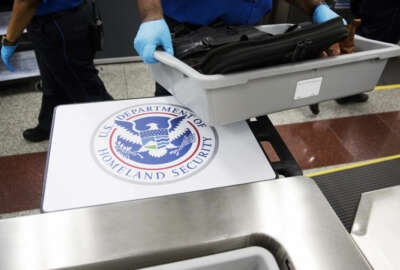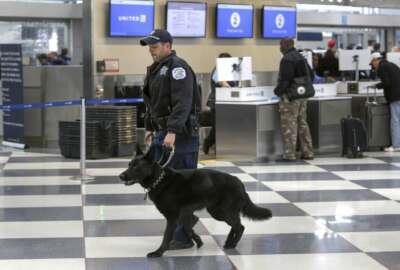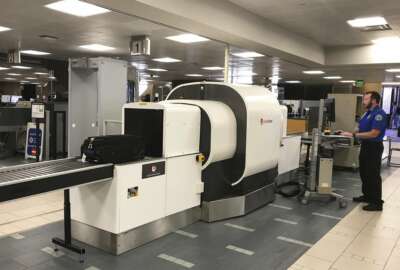
TSA experiments with new technologies to make air travel safer, more convenient
TSA is testing biometric devices like fingerprint scanners and facial recognition, as well as 3D imaging and automation to improve security, reduce wait at airport...
As you’re standing in line at a security checkpoint on your way home for Thanksgiving, taking off your shoes and wondering if your toothpaste tube is small enough to avoid confiscation, take a look around. Are there multiple screening lanes? Do they look automated? Did you notice license-plate-scanning cameras on the way into the airport? Did you scan your fingerprints when Transportation Security Administration employees checked your documents? If so, you might be getting a sneak peek at the future of aviation security.
Steve Karoly, acting administrator in the office of Requirements and Capabilities Analysis at the TSA, said these are just a few of the initiatives that the agency’s innovation task force is piloting at a handful of airports.
“It’s a group of individuals who really breathe, eat and sleep innovation,” Karoly said on DHS 15th Anniversary. “That’s what they think about full time. But they’re backed up by a bunch of colleagues across TSA and in some cases across [the Homeland Security Department].”
He said the task force has TSA members from the IT, Intelligence and Training offices, just to name a few, because each office has a role in informing or supporting technical or procedural innovations in security. But outside of TSA, the agency works with different DHS components, like Customs and Border Protection, to leverage innovations those agencies are working on.
For example, CBP has been working on biometric scanners for entry and exit to the country, which would scan fingerprints or perform facial recognition upon entry, and alert officials if subjects did not exit the country by the allotted time. TSA is looking at the possibility of integrating those systems into all commercial flights.
Currently, Karoly said those systems are being piloted at both the Denver and Atlanta airports. TSA is collecting data on the biometric systems through an opt-in program that allows travelers who registered their fingerprints as part of the pre-check vetting system to check in by scanning their fingerprints instead of presenting documents.
TSA is also looking at introducing facial recognition in the near future.
“We are just getting into our next phase of our biometric authentication technology initiative and that will look at both facial recognition at the travel document checker area as well as working with our airport authorities and airlines that already have cameras around the airports and trying to capture that data,” Karoly said.
The idea is to begin by using facial recognition to ensure that the person who presents identification in the form of a passport or license is in fact the person who owns the license. But there is one roadblock TSA has to overcome: Identification photos don’t have enough depth for the facial recognition software to make a match.
But there is a workaround TSA is looking at implementing. Passports are currently equipped with a chip, and one of the things on that chip is a digital version of the picture, which does have enough depth for facial recognition. So TSA is looking into working with authorities that issue photo identifications like driver’s licenses to possibly begin including a chip with those as well.
Two more initiatives TSA is looking at piloting are scanners for bottled liquids, so passengers can start bringing larger bottles with them again, and a new system called computed tomography.
“[Computed tomography] uses 3D imaging to screen baggage at the checkpoint,” Karoly said. “In today’s environment, we have that technology down in the checked baggage area in many airports. The reason it wasn’t brought up to the checkpoint sooner was the fact that it is very large and very costly, years back, and it couldn’t fit into the checkpoint environment.”
The system basically electronically unpacks your bag, but without opening it, and in less time than it would take a person to do so. It’s currently in pilot mode at Boston and Pheonix airports.
And Atlanta is currently undergoing tests of a new automated security checkpoint, which provides more lanes for travellers to scan their carry-on items, and tracks the bins using cameras and RFID tags.
All of this is part of a new way of looking at airport security, referred to as the “aviation security ecosystem.”
“A checkpoint is just part of that aviation security ecosystem,” Karoly said. “If we’re looking across the band, we want to have a primary means to make sure that we can create a curb-to-gate security environment.”
But that curb-to-gate security environment requires collaboration among a great number of moving parts. And TSA is still learning how to leverage its many partnerships with other agencies, local law enforcement, and private companies such as airlines and airport authorities, in order to tie the whole system together in an agile way.
Copyright © 2025 Federal News Network. All rights reserved. This website is not intended for users located within the European Economic Area.
Daisy Thornton is Federal News Network’s digital managing editor. In addition to her editing responsibilities, she covers federal management, workforce and technology issues. She is also the commentary editor; email her your letters to the editor and pitches for contributed bylines.
Follow @dthorntonWFED
Related Stories





